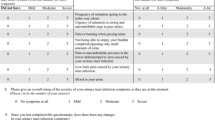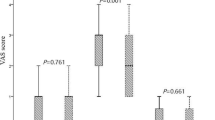Abstract
Introduction and hypothesis
The purpose of the study was to determine if there is a difference in pain during and after multichannel urodynamic testing in women when using 2% lidocaine gel versus water-based lubricant.
Methods
This was a randomized, controlled, double-blinded study. Women scheduled to undergo urodynamic testing were invited to participate. Participants were randomized to lidocaine 2% gel or water-based lubricant for use during testing. Both participant and examiner were blinded to the type of gel. Pain was assessed by the Wong–Baker pain scale from 0 to 10 at four points during the examination. After testing, participants completed a questionnaire to assess their expectations of pain and embarrassment with urodynamic testing. The examiner also completed a questionnaire to assess his/her impression of the participant’s pain during the procedure.
Results
The women in the lidocaine group had lower pain scores after the cotton tipped swab test (1.3 vs 3.6, lidocaine vs lubricant respectively, p < 0.001) and after placement of urodynamic catheters (1.4 vs 3.9, lidocaine vs lubricant, respectively, p < 0.001). Mean pain scores 30 min post-completion of the study were similar between groups (0.7 vs 1.2, 1.4 vs 3.9, lidocaine vs lubricant respectively, p = 0.19). Participants reported that pain during the study was better than expected in both groups. Physician perception of the participant’s pain during testing was lower in the lidocaine group (2 vs 3, lidocaine vs lubricant respectively p = 0.008).
Conclusion
Use of 2% lidocaine gel during in and out catheterization, cotton-tipped swab test, and urodynamic testing decreases pain during these procedures.

Similar content being viewed by others
References
Harmanli OH, Okafor O, Ayaz R, Knee A. Lidocaine jelly and plain aqueous gel for urethral straight catheterization and the Q-tip test: a randomized controlled trial. Obstet Gynecol. 2009;114(3):547–50.
Goldfischer ER, Cromie WJ, Karrison TG, et al. Randomized, prospective, double-blind study of the effects on pain perception of lidocaine jelly versus plain lubricant during outpatient rigid cystoscopy. J Urol. 1997;157(1):90–4.
Stein M, Lubetkin D, Taub HC, et al. The effects of intraurethral Iidocaine anesthetic and patient anxiety on pain perception during cystoscopy. J Urol. 1994;151:1518–21.
Rodríguez-Rubio F, Sanz G, Garrido S, et al. Patient tolerance during outpatient flexible cystoscopy—a prospective, randomized, double-blind study comparing plain lubrication and lidocaine gel. Scand J Urol Nephrol. 2004;38(6):477–80.
Patel AR, Jones JS, Babineau D. Lidocaine 2% gel versus plain lubricating gel for pain reduction during flexible cystoscopy: a meta-analysis of prospective, randomized, controlled trials. J Urol. 2008;179(3):986–90.
Yiou R, Audureau E, Locj CM, et al. Comprehensive evaluation of embarrassment and pain associated with invasive urodynamics. Neurourol Urodyn. 2015;34:156–60.
Stav K, Ohlgisser R, Siegel YI, et al. Pain during female urethral catheterization: intraurethral lubricant injection versus catheter tip lubrication—a prospective randomized trial. J Urol. 2015;194:1018–21.
Wong D, Baker C. Pain in children: comparison of assessment scales. Pediatr Nurs. 1988;14(1):9–17.
Segev Y, Rosen T, Auslender R, et al. How painful is multichannel urodynamic testing? Int Urogynecol J Pelvic Floor Dysfunct. 2009;20(8):953–5.
Yokoyama T, Nozaki K, Nose H, et al. Tolerability and morbidity of urodynamic testing: a questionnaire-based study. Urology. 2005;66(1):74–6.
Tanabe P, Steinmann R, Anderson J, et al. Factors affecting pain scores during female urethral catheterization. Acad Emerg Med. 2004;11(6):699–702.
Chung CM, Paoloni R, O’Brien MJ, et al. Comparison of lignocaine and water based lubricating gels for female urethral catheterization: a randomized controlled trial. Emerg Med Australas. 2007;19:315–9.
Ellerkmann RM, McBride AW, Dunn JS, et al. A comparison of anticipatory and postprocedure pain perception in patients who undergo urodynamic procedures. Am J Obstet Gynecol. 2004;190(4):1034–8.
Author information
Authors and Affiliations
Corresponding author
Ethics declarations
Conflicts of interest
None.
Additional information
ClinicalTrials.gov identifier: NCT01612156
Rights and permissions
About this article
Cite this article
Özel, B.Z., Sun, V., Pahwa, A. et al. Randomized controlled trial of 2% lidocaine gel versus water-based lubricant for multi-channel urodynamics. Int Urogynecol J 29, 1297–1302 (2018). https://doi.org/10.1007/s00192-018-3576-8
Received:
Accepted:
Published:
Issue Date:
DOI: https://doi.org/10.1007/s00192-018-3576-8




